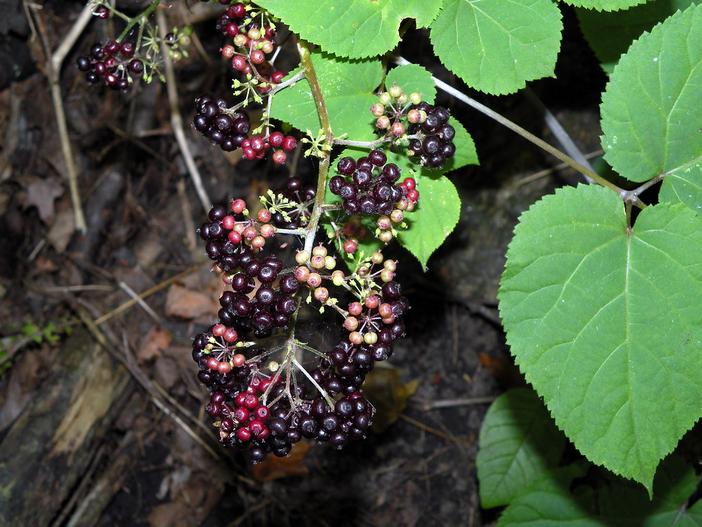American Spikenard
(Aralia racemosa)
American Spikenard (Aralia racemosa)
/
/

Doug McGrady
CC BY 2.0
Image By:
Doug McGrady
Recorded By:
Copyright:
CC BY 2.0
Copyright Notice:
Photo by: Doug McGrady | License Type: CC BY 2.0 | License URL: https://creativecommons.org/licenses/by/2.0/ | Uploader: Doug_McGrady | Publisher: Flickr






































































Estimated Native Range
Summary
Aralia racemosa, commonly known as American Spikenard, is a deciduous perennial herb native to rich, moist deciduous woodlands, and thickets of the eastern United States and Canada. It typically grows 1 to 2 meters (3 feet 3 inches to 6 feet 7 inches) tall and is noted for its large compound leaves and loose panicles of small, greenish-white flowers that bloom in late summer. The flowers are followed by dark purple berries that are attractive to birds. The plant’s large, bushy form and interesting foliage make it a striking addition to shade gardens.
American Spikenard is valued for its adaptability to a range of soil conditions and its ability to thrive in part shade, making it a versatile choice for woodland gardens, naturalized areas, and shaded borders. It requires consistently moist soil and benefits from a layer of mulch to retain soil moisture. While it prefers part shade, it can tolerate full sun if kept sufficiently moist. The plant is also known for its historical medicinal uses, with roots that were traditionally used for a variety of ailments. However, it is not commonly used in modern herbal medicine. Gardeners should be aware that Aralia racemosa can spread by root suckers to form colonies, which may require management in smaller garden settings.CC BY-SA 4.0
American Spikenard is valued for its adaptability to a range of soil conditions and its ability to thrive in part shade, making it a versatile choice for woodland gardens, naturalized areas, and shaded borders. It requires consistently moist soil and benefits from a layer of mulch to retain soil moisture. While it prefers part shade, it can tolerate full sun if kept sufficiently moist. The plant is also known for its historical medicinal uses, with roots that were traditionally used for a variety of ailments. However, it is not commonly used in modern herbal medicine. Gardeners should be aware that Aralia racemosa can spread by root suckers to form colonies, which may require management in smaller garden settings.CC BY-SA 4.0
Plant Description
- Plant Type: Subshrub, Herb
- Height: 3-5 feet
- Width: 3-5 feet
- Growth Rate: Moderate
- Flower Color: N/A
- Flowering Season: Summer
- Leaf Retention: Deciduous
Growth Requirements
- Sun: Full Sun, Part Shade
- Water: Medium
- Drainage: Slow, Medium, Fast
Common Uses
Bee Garden, Bird Garden, Butterfly Garden, Drought Tolerant, Edible*Disclaimer: Easyscape's listed plant edibility is for informational use. Always verify the safety and proper identification of any plant before consumption., Low Maintenance
Natural Habitat
Rich, moist deciduous woodlands and thickets
Other Names
Common Names: Indian Root, Life-Of-Man, Spice Berry, Old-Man’s-Root, Petty Morel, American-Spikenard, Indian-Root, Small-Spikenard, Spiceberry, Spignet
Scientific Names: , Aralia racemosa, Aralia racemosa subsp. racemosa, Aralia racemosa f. racemosa, Aralia racemosa var. foliosa, Aralia racemosa f. foliosa,
GBIF Accepted Name: Aralia racemosa L.